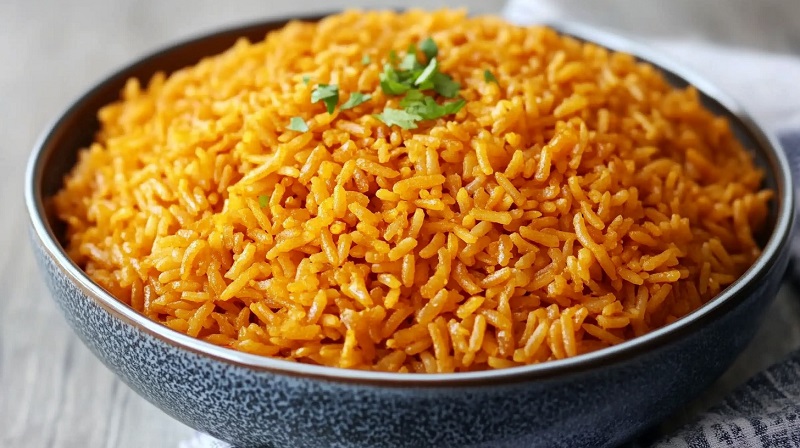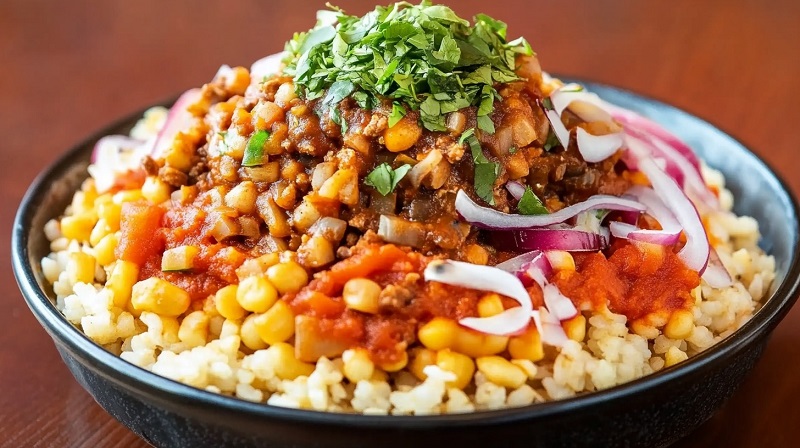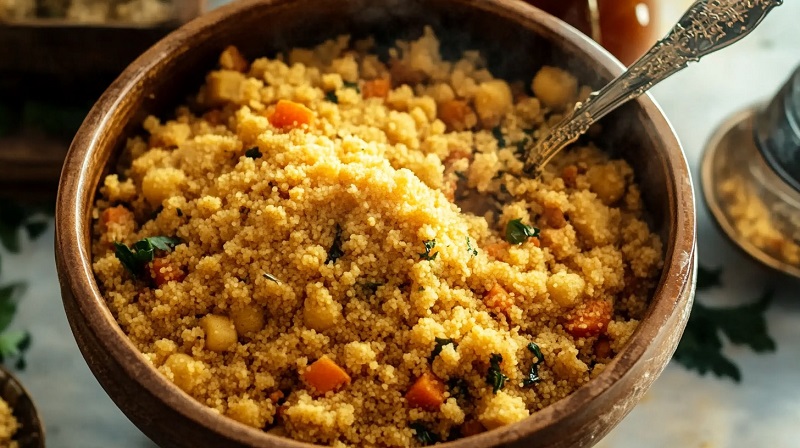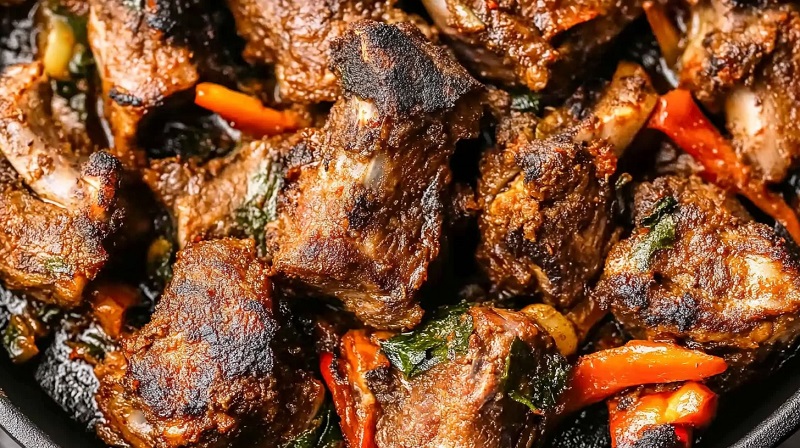Africa’s culinary heritage presents a vast array of flavors, techniques, and local traditions that define everyday life and celebration across the continent. Food in Africa isn’t just nourishment, it’s memory, identity, ritual, and hospitality.
Travelers who seek meaningful cultural experiences often find that local dishes offer more than just sustenance—they become an entry point into understanding how people live, share, and connect.
Selection of the top dishes draws on their authenticity, widespread acclaim, representation across multiple regions, and distinctive preparation and flavor.
1. Jollof Rice – West Africa (Nigeria, Ghana, Senegal)

Spiced and tomato-rich, Jollof rice has earned its place as a culinary icon in West Africa. Cooked with long-grain parboiled rice, tomatoes, onions, red pepper, and a mix of bold spices, it often includes meat, vegetables, or seafood depending on regional styles.
Nigerian versions come bold and peppery, Ghanaian renditions lean toward a balanced tomato base, and Senegalese “thieboudienne” offers a fish-forward variation.
More than a staple, it’s a source of national pride. Weddings, birthdays, and holidays often revolve around large pots of Jollof, and the ongoing friendly rivalry between nations over who makes it best fuels constant culinary innovation.
In cities like Lagos, Accra, and Dakar, street vendors and upscale chefs alike present Jollof in all its spirited variations, making these places essential stops for those in search of authentic flavor.
Ideal Travel Destinations:
- Lagos, Nigeria – Known for bold, spicy Jollof
- Accra, Ghana – Balanced flavors and smoky aroma
- Dakar, Senegal – Home of the original thieboudienne
2. Injera with Wot – East Africa (Ethiopia, Eritrea)
Sour, spongy, and impossibly versatile, injera serves as both plate and utensil across Ethiopia and Eritrea. Made using fermented teff flour, injera pairs with wot—spicy stews rich with lentils, vegetables, or meats like doro (chicken) and sega (beef).
The texture, tanginess, and depth of spices combine to create a bold and memorable eating experience.
Eating injera is a communal act, often shared on a single large platter. Families and friends gather to scoop portions of stew using their hands, emphasizing hospitality and connection. Such meals go far beyond taste—they nurture bonds.
In Addis Ababa or Asmara, dining establishments range from traditional homes to cultural restaurants that celebrate music and ritual alongside food.
Ideal Travel Destinations:
- Addis Ababa, Ethiopia – Home to iconic teff farms and traditional dining
- Asmara, Eritrea – Blends Italian influence with centuries-old food customs
3. Koshari – North Africa (Egypt)

Layers of lentils, rice, chickpeas, and macaroni come together in koshari—a dish that tells a story of ingenuity and comfort. Topped with spicy tomato sauce, crispy fried onions, and optional garlic vinegar or chili oil, it delivers a punch of texture and bold flavor in every bite.
Koshari evolved in 19th-century Cairo as a street food for workers. Over time, it became a staple of Egyptian home cooking, known for being filling, affordable, and deeply satisfying.
Its combination of starches and legumes may seem unusual, but the harmony in flavor and contrast in textures make it an unforgettable meal.
Today, it’s served everywhere, from roadside stalls to ultra deluxe Nile cruises. Vendors scoop ingredients assembly-line style, allowing customers to choose their preferred ratios of rice, lentils, and sauce. The dish also adapts easily to vegetarian and vegan diets, which adds to its popularity.
Ideal Travel Destination:
- Cairo, Egypt – Visit El Tahrir Koshari or Abou Tarek for street-style excellence
4. Bobotie – Southern Africa (South Africa)

Sweet and savory, bobotie brings minced meat to life with mild curry spices, raisins, almonds, and a golden egg custard baked on top.
A relic of colonial culinary fusion, it reflects both Dutch and Cape Malay traditions. Served with yellow rice and chutney, its flavor profile is a perfect balance of warmth and gentle sweetness.
In South Africa, bobotie has made its way from historical cookbooks to restaurant menus and everyday home kitchens. Celebrated as one of the country’s national dishes, it often represents festive occasions and communal feasting.
Cape Town serves as a hub for this dish, especially in the Bo-Kaap neighborhood where Cape Malay heritage is preserved through food, color, and tradition.
Ideal Travel Destination:
- Cape Town, South Africa – Historic roots and innovative interpretations
5. Fufu and Light Soup – West Africa (Ghana, Ivory Coast)
Soft, stretchy, and satisfying, fufu is made by pounding boiled cassava, yam, or plantain into a dough-like consistency. Paired with light soup—a spicy, tomato-based broth often cooked with goat, chicken, or fish—the result is a dynamic duo that defines West African comfort food.
Fufu isn’t chewed. Pieces are pinched off, rolled by hand, and dipped into soup before swallowing whole. That tactile experience plays a central role in how meals are enjoyed across Ghana and Ivory Coast. Each bite becomes part of a rhythm shaped by conversation, laughter, and shared presence.
In Accra and Abidjan, restaurants and local joints serve variations that reflect tribal traditions and seasonal ingredients. Street-side spots often provide the most authentic textures and flavors.
Ideal Travel Destinations:
- Accra, Ghana – Accessible, delicious fufu with goat light soup
- Abidjan, Ivory Coast – Creamier fufu textures and fish-based soups
6. Couscous – North Africa (Morocco, Tunisia, Algeria)

Fine grains of semolina steamed to fluffy perfection, couscous is the centerpiece of Friday gatherings and ceremonial meals in North Africa. Served with vegetables, chickpeas, meat, and aromatic broth, it represents patience and hospitality. Preparation may take hours, with layers of flavor developed through slow simmering and careful seasoning.
Often paired with lamb or chicken, and topped with caramelized onions and raisins, couscous reflects the culinary legacy of Berber communities and Islamic culinary customs. The dish signals abundance and togetherness.
Casablanca, Tunis, and Algiers each offer unique takes—flavor variations emerge in the type of broth used, the meat chosen, or the spices added to the base.
Ideal Travel Destinations:
- Casablanca, Morocco – Broth-heavy couscous with root vegetables
- Tunis, Tunisia – Spicier blends and seafood combinations
- Algiers, Algeria – Earthy stews and cinnamon-scented onions
7. Piri-Piri Chicken – East & Southern Africa (Mozambique)
Bold and fiery, piri-piri chicken is flame-grilled after being marinated in a mixture of crushed chilies, garlic, citrus juice, vinegar, and oil. The result: a crispy, juicy dish that bites back with heat while layering on smoky and tangy undertones.
Born of Portuguese colonial influence, the dish evolved in Mozambique where local spices intensified its profile. Today, it’s a national favorite and a must-try for spice lovers. Often served with fries, rice, or a simple salad, it’s both street food and restaurant fare.
Maputo pulses with piri-piri energy—markets, food stalls, and beachfront grills all offer variations on this classic.
Ideal Travel Destination:
- Maputo, Mozambique – Street vendors and family-owned grills serve the boldest flavors
8. Muamba de Galinha – Central Africa (Angola, DR Congo)
A dish that feels both rustic and rich, muamba de galinha brings chicken together with palm oil, garlic, okra, and occasionally peanut butter.
Cooked slowly, the stew develops layers of texture and taste—earthy, nutty, and slightly spicy.
Often served with rice or funge (a cassava-based accompaniment), muamba is a staple of Angolan and Congolese households. Celebrations, funerals, and casual family meals all welcome it to the table.
Luanda and Kinshasa offer some of the most comforting, home-style versions of this dish. Expect dense flavors, generous portions, and a depth rarely matched elsewhere.
Ideal Travel Destinations:
- Luanda, Angola – Traditional preparation with peanut-rich sauces
- Kinshasa, DR Congo – Heartier stews with added vegetables and okra
9. Nyama Choma – East Africa (Kenya, Tanzania)

Goat meat sizzling over open flame, seasoned with salt and nothing more, creates one of East Africa’s most beloved dishes.
Nyama choma is about more than just the meat, it’s about leisure, friendship, and long afternoons spent with beer, conversation, and hands greasy with flavor.
In Kenya and Tanzania, meat is grilled slowly over charcoal, then hacked into bite-sized pieces and served with kachumbari (fresh tomato and onion salad) or ugali (maize meal). Simplicity is key, but the result delivers immense satisfaction.
Visit Nairobi or Arusha for the full experience. Roadside stands, local taverns, and grill joints offer not only food but music and laughter.
Ideal Travel Destinations:
- Nairobi, Kenya – Bustling nyama choma spots filled with music and crowds
- Arusha, Tanzania – Meat grilled over volcanic rock charcoal for a smoky edge
10. Yassa Poulet – West Africa (Senegal, Gambia)
Bright and bold, Yassa poulet begins with marinated chicken, soaked in a mixture of lemon juice, mustard, onions, garlic, and chili. Grilled then simmered, the dish gains layers of savory and citrusy flavor, often served over rice.
Its origins trace back to the Casamance region of Senegal, but it has since spread across West Africa as a dish of celebration and welcome. Homes and restaurants alike take pride in their Yassa, tweaking the marinade or serving style but keeping the punchy flavor intact.
Dakar and Banjul provide ideal settings to try Yassa poulet, especially at coastal eateries where fresh chicken meets open flame and heritage seasoning.
Ideal Travel Destinations:
- Dakar, Senegal – Zesty marinades and grilled street-style versions
- Banjul, Gambia – Homey flavors with extra mustard and citrus notes
Summary
Africa’s culinary depth offers more than flavor, it represents heritage, identity, and shared life. Each dish tells a story shaped by time, geography, and community.
Traveling with food in mind opens new perspectives and invites connection at every table.
As visitors seek authentic experiences, African cuisine offers one of the most rewarding ways to engage with tradition.
Choosing to support local markets, family-run eateries, and ethical food producers makes a positive impact while preserving these treasured dishes for generations to come.











